Abstract
To preserve the sustainability of Quercus robur forests, which is at risk due to the disturbed natural regeneration, human assisted sowing of acorns or planting of oak seedlings is often performed. However, the success of these methods depends greatly on the use of high-quality sowing and planting material. Thermotherapy is thus often employed to decrease the acorn mycobiota and maintain their quality during the storage. The aim of this study was to test the impact of acorn thermotherapy, followed by a short-term storage at −1 °C or 3 °C, on the quality of related oak seedlings, which was assessed based on the easily observable morphological characteristics. Height, root collar diameter and seedling form were measured or noted for the 1284 and 1190 seedlings at the age of four months and three years, respectively. It was found that acorn thermotherapy affirmatively affected seedling height, especially at the early growth stage. Positive impact on other seedling attributes could not be decisively confirmed because of the lack of the continuity of the effect (not visible in both younger and older seedlings) and the prevailing impact of other factors. Different acorn thermotherapy conditions (temperature and duration) and short-term storage temperatures appeared to be associated only with the occurrence of stem forking at the earlier stage of seedling growth.
1. Introduction
Quercus robur L. (English oak, pedunculate oak) is one of the most valued forest tree species in Europe, both in ecological and economical terms. Its wood is utilized for the production of high-quality and construction timber and its forests harbor a variety of different animal, plant and fungal species, greatly contributing to the overall biodiversity [1,2]. However, these ecosystems and the benefits they provide are at risk of degradation, as the synergistic activity of various biotic and abiotic factors has led to their increased decline and impeded natural regeneration during the last decades [3,4,5,6]. One potential means of preservation of oak forest continuity in cases of hindered natural regeneration is to assist natural processes by sowing acorns collected in other areas or by planting oak seedlings produced in nurseries [7]. However, for these human assisted methods to succeed, it is essential to ensure the sufficient amounts of high-quality acorns and forest seedlings [8,9].
Seedling quality is crucial for its field performance, that is, its survival and growth after planting. It is usually assessed by measuring or evaluating its morphological and physiological characteristics [10]. Morphological attributes of broadleaf seedlings which are considered in the characterization of their quality are: seedling height, stem diameter, height, diameter ratio, bud length, shoot and root mass and their ratio, foliar color and the seedling form [11,12,13]. The last category refers to distinguishing normal seedlings from the ones with root deformations or multiple, forked, brushy, deformed and damaged stems [13,14]. Physiological characteristics which determine the quality of seedlings (cold hardiness, root growth potential, bud dormancy, etc.) are less frequently evaluated in forest nurseries as their assessment is more laborious and time-consuming [11,12,13].
Whether it is appraised based on morphological or physiological attributes, or both, seedling quality is closely associated with nursery practices applied during its production and with the quality of the acorn it originated from [11,12,15,16,17,18]. The latter is determined by the size of the acorn, its weight, viability, moisture content, mineral nutrient reserves, levels of insect and fungus damage and germination [16,19,20,21,22]. Pedunculate oak acorns belong to a group of recalcitrant seeds, meaning they have a high moisture content, which makes them more susceptible to a loss of quality due to desiccation or fungal infection, especially during storage [23,24]. The former is prevented by maintaining the acorn moisture content at the 40% at least, which can be achieved by a proper choice and combination of storage conditions, such as temperature, duration, type of storage containers, used medium (e.g., dry peat, sawdust, or no medium), etc. [24,25,26,27]. Fungal infections can also be successfully prevented or controlled by storing the acorns under the adequate conditions and by applying eradicative treatments which target harmful pathogens prior to storage. Detrimental fungi can be inhibited or eliminated from the acorns with the use of fungicides, biological control agents (antagonistic fungi or bacteria), disinfectants, steam or hot water [28,29,30]. The use of the latter two is referred to as a thermotherapy. Thermotherapy treatment, usually conducted by submerging the acorns for 2.5 h in a water preheated to 41 °C, is proven to be effective in reducing the overall acorn mycobiota, including one of the most damaging fungal pathogens of oak acorns during the storage, Ciboria batschiana [28,30,31,32,33]. However, not all fungi can be eliminated by this treatment, which can potentially result in their proliferation during the acorn storage and the subsequent loss of acorn quality. Several studies have reported higher abundance of ubiquitous mold fungi from genera Penicillium and Mucor on stored acorns treated by thermotherapy in comparison with the non-treated ones [30,33,34,35].
Still, thermotherapy is considered to be an efficient method for the control of acorn mycobiota, as the ubiquitous proliferating fungi which can be induced by its application have not yet been proven to reduce the acorn germination after short-term storage [30,33]. Moreover, thermotherapy has been associated with higher acorn viability and germination rates, indicating it does not adversely affect the quality of acorns if combined with the appropriate storage conditions [29,30,33,36]. However, still little is known about the effect of acorn thermotherapy and storage on the characteristics of related seedlings, as there are not many available studies on this topic and most of them are primarily focused on the storage alone [29,37,38,39,40].
The aim of this research was to investigate the impact of thermotherapy treatments of different temperatures and durations, followed by a short-term storage at two different temperatures, on the chosen morphological characteristics of related seedlings. This study was conducted as a follow-up to the research published in 2021, which confirmed the association of thermotherapy and storage temperature with the Q. robur acorn quality regarding fungal presence and germination [33].
2. Materials and Methods
Quercus robur acorns were collected from the forest ground in October 2017. Collection points were located around the Training and Research Forest Centre Lipovljani in Croatia, which is managed by the University of Zagreb, Faculty of Forestry and Wood Technology (45.3744° N, 16.8208° E). Prior to a further analysis, the acorns were floated in water twice for 15 min and visually inspected. The empty and insect-damaged ones were discarded. The 1000-seed weight was 2238 g.
2.1. Acorn Treatment and Storage
A total of 1600 acorns was exposed to four thermotherapy treatments which differed in applied temperature and/or duration. Groups of 400 acorns were treated at 41 or 45 °C for 2.5 and 5 h at each temperature (Table 1). For this purpose, each group was submerged in 3 L of water preheated to 41 or 45 °C in a separate polyvinyl chloride (PVC) container and then incubated at the same temperature for 2.5 or 5 h in a growth chamber (Kambič RK-980 CHCO2, Semič, Slovenia). Control group consisted of 400 non-treated acorns.

Table 1.
Different thermotherapy treatment conditions applied to groups of Quercus robur acorns.
After the treatment, acorns were removed from the containers and left at the room temperature for several hours to superficially dry before storage. All groups of acorns (one control and four treated) were divided in halves, which were stored separately in sealed PVC bags at two different temperatures for two months. One half (200 acorns from each treatment group) was stored in a laboratory freezer at −1 °C (Pol-Eko-Aparatura ZLN-T 300, Wodzisław Śląski, Poland), and the second half was stored in a laboratory refrigerator at 3 °C (Kirsch Super-720, Offenburg, Germany).
2.2. Morphological Characteristics of Seedlings
In order to monitor the morphological characteristics of related seedlings, thermotherapy-treated and control acorns were sown on 3 May 2018 in 10 blocks corresponding to 10 groups exposed to different thermotherapy conditions and storage temperatures (eight treated groups and two control ones) (Figure 1). Acorns were treated with contact fungicide (35% copper + 2% zinc) and sown in 4 rows per 50 in each block. Depth of sowing was 5 cm. This open field trial took place in the nursery “Šumski vrt i arboretum” located at the University of Zagreb, Faculty of Forestry and Wood Technology (45.8202° N, 16.0228° E).
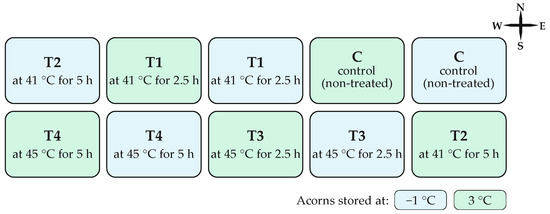
Figure 1.
Block distribution of sown Quercus robur acorn groups exposed to different thermotherapy treatment conditions and storage temperatures in the nursery.
First seedlings emerged 21 days after the sowing (germination 4.4%). Germination monitored on 63rd day varied from 55 to 79%, depending on the group [33].
Seedlings were first assessed 132 days after the acorns were sown (111 days after the emergence of first seedlings, on 12 September 2018, at approximate age of four months) and again approximately three years after their emergence (on 20 May 2021). The following morphological characteristics were measured, calculated or noted for each emerged seedling:
- height of the main stem (H, mm), measured from the ground level to the base of the terminal bud
- root collar diameter (D, mm), measured at the ground level
- height: diameter ratio (H/D), the ratio of the main stem height (H) and the root collar diameter (D)
- presence of a forked stem (separation of the main stem in two stems above ground level, FS, yes/no) (Figure 2)
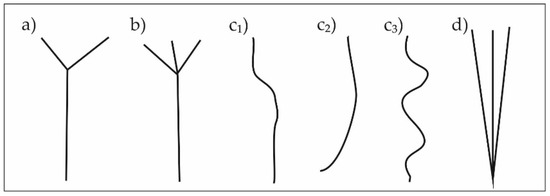 Figure 2. Observed morphological characteristics of Quercus robur seedlings: (a) forked stem; (b) brushy stem; (c) deformed stem; (d) multiple main stems.
Figure 2. Observed morphological characteristics of Quercus robur seedlings: (a) forked stem; (b) brushy stem; (c) deformed stem; (d) multiple main stems. - presence of a brushy stem (separation of the main stem in three or more stems above ground level, BS, yes/no) (Figure 2)
- presence of a deformed stem (DS, yes/no) (Figure 2)
- presence of multiple (more than one) main stems growing from the ground level (MS, yes/no) (Figure 2)
- occurrence of more than one stem abnormality (forked, brushy, deformed or multiple main stems) on a single seedling (ABN, yes/no)
Impact of thermotherapy treatment conditions and storage temperatures on observed morphological characteristics was evaluated using analysis of variance (ANOVA) or Chi-square test of independence, depending on the nature of tested variables (numeric or categorical). Fulfilment of the assumption of a variance homogeneity among tested groups was checked with Levene’s test before using ANOVA. To determine which groups make a significant difference, post-hoc testing was conducted using Tukey’s HSD test (following ANOVA) or z-test on the adjusted residuals with Bonferroni correction (following Chi-square) [41]. Statistical analyses were performed in the IBM SPSS Statistics software package for Windows, Version 23.0. (IBM Corp., Armonk, NY, USA).
3. Results
3.1. Morphological Characteristics of Four Months Old Seedlings
Approximately four months after sowing 2000 acorns, a total of 1284 seedlings had grown and were alive at the time of the first assessment (Figure 3). Their average height and root collar diameter were 241 ± 87 mm and 4.54 ± 1.57 mm, respectively.
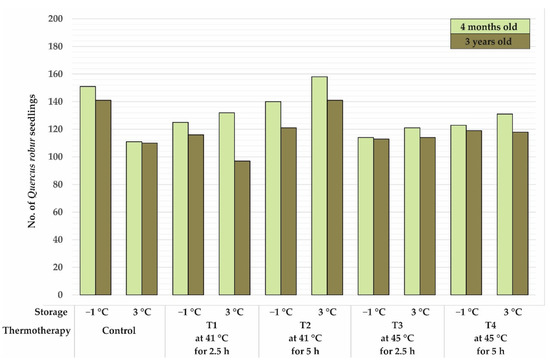
Figure 3.
Number of alive Quercus robur seedlings at the age of four months and at the age of three years, grown from acorns exposed to different thermotherapy and storage conditions.
Morphological characteristics of seedlings were measured, calculated or observed and then compared across different thermotherapy (four treatments and control) and storage categories (at −1 and 3 °C). Statistical tests revealed that acorn thermotherapy and storage had a significant impact on the height of the related seedlings and on their height: diameter ratio, and were significantly associated with presence of forked stems and appearance of more than one stem abnormality (forked, brushy, and deformed or multiple main stems) on a single seedling (Appendix A, Table A1).
Tukey’s post-hoc HSD test showed that the main stem height and the height: diameter ratio of seedlings originating from control acorns (C) were significantly lower comparing to treated groups, regardless of the acorn storage temperature (except the H/D ratio of the control group stored at 3 °C compared to T2 group stored at 3 °C) (Figure 4 and Figure 5).
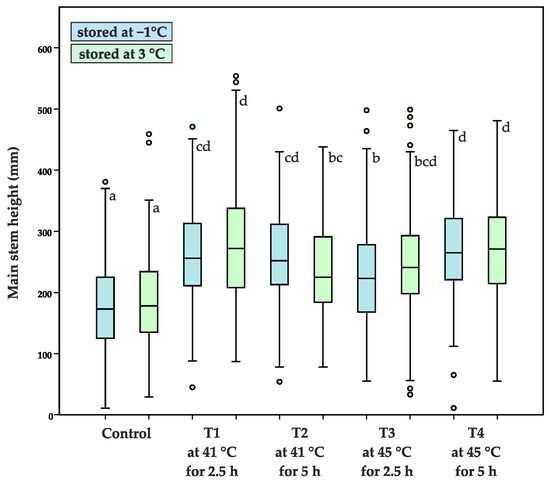
Figure 4.
Height of the main stem of four months old Quercus robur seedlings from acorns exposed to different thermotherapy and storage conditions, with significant differences (p < 0.05) represented by different letters (circles denote outliers).

Figure 5.
Height: diameter ratio of four months old Quercus robur seedlings from acorns exposed to different thermotherapy and storage conditions, with significant differences (p < 0.05) represented by different letters (circles denote outliers).
A post-hoc z-test revealed that stem forking was significantly more frequent in seedlings from acorns treated at 45 °C for 5 h (T4) and stored at 3 °C. The same post-hoc test showed that seedlings from the control acorns stored at −1 °C were more likely to have more than one stem abnormality present (Figure 6).
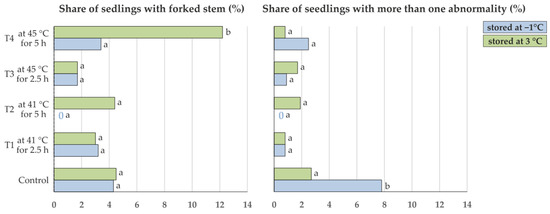
Figure 6.
Share of Quercus robur seedlings with a particular form at the age of four months, grown from acorns exposed to different thermotherapy and storage conditions (different letters represent significant differences; Bonferroni corrected p < 0.0025).
3.2. Morphological Characteristics of Three Year Old Seedlings
In total 1190 seedlings survived after three years of growth (Figure 3), exhibiting the average main stem height of 879 ± 403 mm and the average root collar diameter of 10.14 ± 4.15 mm.
Morphological characteristics of seedlings were compared among different thermotherapy treatment and storage categories, as previously described for the four month old seedlings. Results of the ANOVA revealed a significant difference in the main stem height, root collar diameter and the height: diameter ratio among some of the seedling groups (Appendix A, Table A1). According to the results of the Chi-square test of independence, the number of seedlings with deformed stems, multiple main stems and more than one stem abnormality also significantly differed among groups (Appendix A, Table A1).
Tukey’s post-hoc HSD test revealed that the main stem height of the seedlings originating from control acorns stored at −1 °C was significantly lower only when comparing to those from acorns exposed to T1 and T4 treatments, regardless of the storage temperature (Figure 7).
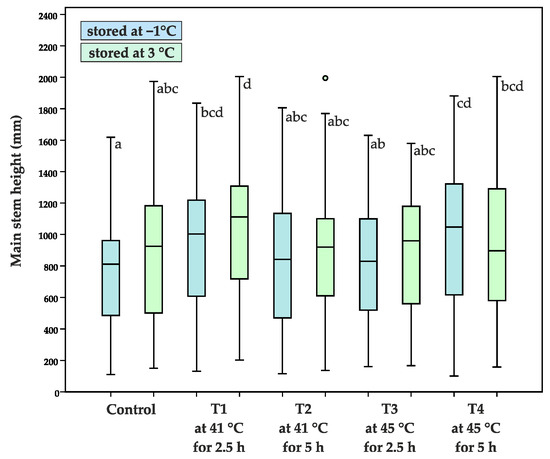
Figure 7.
Height of the main stem of three years old Quercus robur seedlings from acorns exposed to different thermotherapy treatments and storage temperatures, with significant differences (p < 0.05) represented by different letters (circles denote outliers).
Mean root collar diameter of control seedlings was lower in comparison to the diameter of seedlings from all treated groups, regardless of the storage temperature (Appendix A, Table A1). Tukey’s post-hoc HSD test revealed that the difference was statistically significant only when comparing control groups to the T1 group stored at 3 °C (Figure 8).
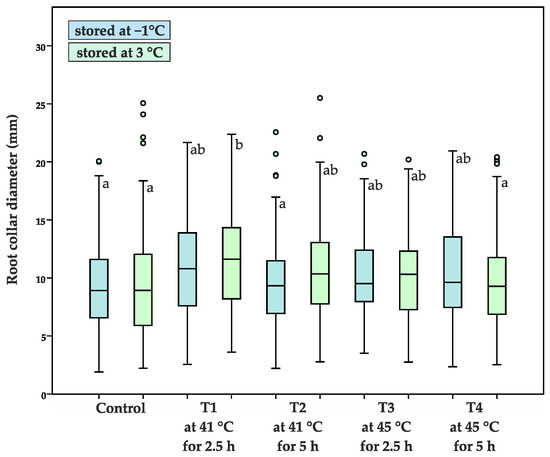
Figure 8.
Root collar diameter of three years old Quercus robur seedlings from acorns exposed to different thermotherapy treatments and storage temperatures, with significant differences (p < 0.05) represented by different letters (circles denote outliers).
Height: diameter ratio of seedlings from control acorns stored at −1 °C was significantly lower in comparison to those from control acorns stored at 3 °C and acorns exposed to T4 treatment, regardless of the storage temperature (Figure 9).
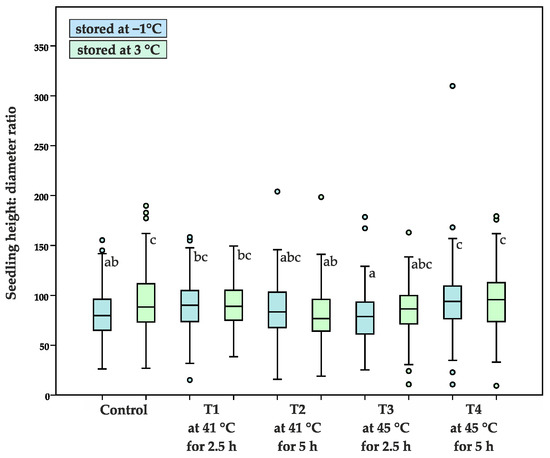
Figure 9.
Height: diameter ratio of three years old Quercus robur seedlings from acorns exposed to different thermotherapy treatments and storage temperatures, with significant differences (p < 0.05) represented by different letters (circles denote outliers).
Deformed stems and the occurrence of more stem abnormalities on a single seedling were statistically more frequent in the seedlings from control acorns stored at −1 °C; while multiple main stems occurred significantly more frequently in the group T1 stored at 3 °C and the group T2 stored at −1 °C (Figure 10).
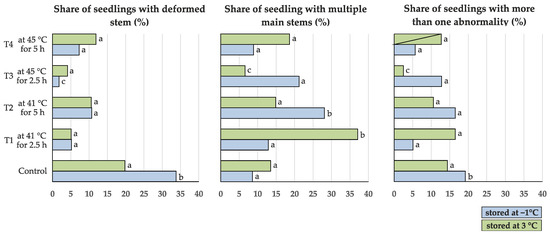
Figure 10.
Share of Quercus robur seedlings with a particular form at the age of three years, grown from acorns exposed to different thermotherapy and storage conditions (different letters represent significant differences; Bonferroni corrected p < 0.0025).
4. Discussion
Nursery production of oak seedlings can substantially contribute to the preservation of forest sustainability by ensuring sufficient amounts of high-quality seedlings with expected good field performance for the rapid and efficient assistance of hindered natural regeneration of oak forests in the cases of disturbances, which are occurring more frequently in recent decades [3,5,7,11]. Although morphological characteristics, especially the height and diameter, are easy to measure and quite reliable as indicators of the seedling quality and its chances for the successful survival and growth in the field [42], there are not many studies on the association of the acorn thermotherapy treatment with the morphology of related oak seedlings. In the study preceding this one, various thermotherapy treatments followed by a short-term storage were found to be beneficial for the quality of pedunculate oak acorns in terms of their mycobiota diversity and nursery germination [33].
Results of this study revealed that the main stem height of pedunculate oak seedlings was also affected by the thermotherapy treatment of acorns. At the age of four months, the height of seedlings from non-treated (control) acorns was significantly lower in comparison to those from treated acorns. The variations in thermotherapy conditions and short-term storage temperatures was not shown to play a decisive role in this phenomenon. Although there were significant differences in height among some treated groups (Figure 4), obvious associations with the thermotherapy conditions nor short-term storage temperature could not be found. For example, the height of seedlings from groups T2 stored at 3 °C and T3 stored at −1 °C was significantly lower comparing to several other treated groups which varied in both thermotherapy and storage conditions. This difference could not be associated with the seedling density either, since the seedling number in the group T2 (3 °C) was the highest and in the group T3 (−1 °C) one of the lowest at the given age. Since climate conditions and nursery practices were the same for all seedlings, and their growth density in blocks did not show clear associations with the stem height (Figure 3 and Figure 4), it can be concluded that acorn thermotherapy positively affected the height of related seedlings, regardless of its duration and temperature. Similar results were obtained in a research conducted on garlic, where bulb thermotherapy has been shown to have a positive impact on the height of different garlic genotypes [43]. Other studies on Quercus spp. confirmed the association of the exposure of acorns to thermotherapy with higher acorn viability, germination rates, and the earlier and more uniform germination [29,30,32,36]. The latter was also noticed in this research (personal observation, data not shown). This indicates that seedlings from treated acorns grew earlier and had a competitive advantage in comparison to those from non-treated acorns and that higher temperatures and duration times of some treatments did not negatively affect this process. Also, the study preceding this one revealed that all conducted thermotherapy treatments reduced the diversity of acorn mycobiota [33], decreasing the probability that some of the harmful fungi will spread during the storage and reduce acorn weight and availability of nutrients, which are considered to be important factors affecting the height of related oak seedlings [16,44,45,46]. However, when seedlings reached three years of age, the differences in stem height between control and treated groups decreased. The significant difference was observed only when comparing the seedlings from control group stored at −1 °C with some of the treated groups (T1 and T4), indicating that differences in height between seedlings from non-treated and treated acorns are surpassed with the increase of seedling age. This could be explained by the greater impact of some other factors on seedling height as they get older [11,47,48,49], and leads to a conclusion that favorable effects of thermotherapy on this attribute are most prominent at early growth stages. Although this should be verified, the genetic basis was most probably the factor which mainly influenced the height of older seedlings in this research, since climate conditions and nursery practices were the same for all seedlings, and their growth density in blocks did not show clear associations with the stem height (Figure 3 and Figure 5).
Root collar diameter was not significantly affected by thermotherapy conditions nor short-term storage temperatures in four month old seedlings. Significantly lower diameter of seedlings in some acorn groups (C and T2 stored at −1 °C, C and T4 stored at 3 °C), compared to the group T1 stored at 3 °C, became noticeable when they reached the age of three years. This difference was most likely caused by the discernible decrease of the number of seedlings and associated plant density in the group T1 stored at 3 °C by the age of three years (Figure 3), which assured more growing space for the diameter increment of plants. Given this, it can be concluded that thermotherapy and short-term storage conditions did not significantly contribute to the growth of root collar diameter of Q. robur seedlings.
Stem height and root collar diameter indicate the ability of seedlings to compete against other plants for light, to grow in volume and to survive various damage induced by animals or abiotic factors, making them an important predictors of seedling quality and field performance [50]. Their ratio can also be used as the characteristic of seedling quality, as it indicates its sturdiness and susceptibility to damage from handling, wind, drought and frost [12,51]. The height: diameter ratio of seedlings in this study was shown to be affected by the acorn thermotherapy both at the age of four months and three years. However, this effect was mostly brought about by the impact of thermotherapy on the seedling height and similarly as with the seedling height, became less prominent with their ageing.
The seedling form, i.e., the presence of stem or crown abnormalities, is often a decisive factor for a seedling disposal, as it is easily observable and can negatively affect seedling field performance [12,18]. In this study, forked stems occurred more frequently in four month old seedlings grown from acorns treated at 45 °C for 5 h (T4) and stored at 3 °C. This could be associated with the impact of high temperatures on the amount and the rate of transport of auxin and phytohormones which stimulate the orthotropic plant growth [52,53] and thus results in the change of the apical growth morphology. Short-term storage at 3 °C might have contributed to this phenomenon, possibly because of the earlier seedling emergence from these acorns [33] and the associated prolonged time of exposure to a terminal bud damage, which is known to be one of the main causative agents of forking [54,55]. However, when seedlings reached the age of three years, the frequency of forked stems increased in all treatment and storage groups to the levels which did not significantly differentiate among them. This rise in the share of forked seedlings with age, from 4% on average to 23%, confirms the critical role of other factors in the phenomenon, such as genetic origin, stem damage and available growing space and phototropism [14,54,56]. Even though oak seedlings in this research grew in the same conditions on a small surface area, they emerged from acorns during the time span of several weeks [33], and part of them grew at the edges of the sowing blocks (Figure 1), which provided the possibility for the aforementioned factors to impact the seedling form.
The appearance of more abnormalities, that is, more than one deviation from the normal form on a single seedling, was shown to be significantly more present in both younger and older seedlings belonging to the control group (C) stored at −1 °C. These results suggest that the omission of acorn thermotherapy, accompanied with the lower storage temperature, contributed to a development of the undesired seedling forms. This could be due to the less uniform and later germination of these acorns, which could have led to the growth deviations due to the less favorable conditions for those seedlings which emerged somewhat later. However, such growth was more likely driven by the genetic origin of seedlings and the relatively high plant density associated with the limited growing space in this group.
When seedlings reached the age of three years, some of the form deviations, namely multiple main stems and stem deformations, were shown to be occurring significantly more frequently in some of the groups. Since this effect was not observed at the earlier age, thermotherapy and short-term storage conditions should be discarded as the contributing factors. The number of seedlings with multiple main stems was significantly higher in the seedlings belonging to groups T1 stored at 3 °C and T2 stored at −1 °C. This parameter could have been influenced by the proximity of sown acorns or damage induced to a shoot just below or at the ground level [55]. The impact of sowing depth [57] can be excluded as this was the same for all acorns. Stem deformations appeared significantly more frequently in seedlings belonging to the control group (C) stored at −1 °C. This could have been brought about by the several factors, like acorn genetic origin, the seedling density and the position in a sowing block and the associated phototrophic growth [56,58]. Therefore, although some of the obtained results indicate that thermotherapy should also be considered as a factor affecting the seedling form, they should be considered as preliminary, as this seedling attribute is influenced by a complex synergistic activity of various other factors which were not thoroughly analyzed in this research.
5. Conclusions
Acorn thermotherapy showed to have a positive impact on the height of the Q. robur seedlings, especially in the early stages of growth. However, it seems that with time this effect becomes less pronounced due to the influence of other factors to which seedlings are exposed. Even though some of the obtained results indicated that root collar diameter was also affirmatively affected by the acorn thermotherapy, this should be discarded because of the lack of the continuity of the effect (visible only in some groups of older seedlings) and the prevailing impact of plant density on this attribute. For similar reasons, that is, the lack of continuity and/or the prevailing impact of other factors, the impact of acorn thermotherapy and short-term storage on the Q. robur seedling form was not decisively confirmed. Also, the thermotherapy conditions (temperature and duration) and the temperature of short-term storage of acorns appeared to be associated only with the occurrence of stem forking at the earlier stage of growth.
This study has revealed that acorn thermotherapy can be related to the improvement of some of the morphological characteristics of Q. robur seedlings, at least at the earliest age. Since their expression is driven by a complex interaction of multiple different factors, thermotherapy should be considered only as a factor partially contributing to the overall effect. Nevertheless, since little or no negative impacts of different acorn thermotherapy conditions on seedling morphology were found in this study, it is plausible to conclude that even the higher temperatures and longer exposure times of acorns will not negatively affect the quality of related seedlings, especially if accompanied by proper storage conditions. Given that the high-quality seedlings are essential for the rapid and successful regeneration of Q. robur forests after various disturbances, and thus the preservation of forest continuity and sustainability, their production in a forest nursery should be preceded by the production of high-quality acorns. Implementation of thermotherapy as an acorn pre-treatment before storage and sowing is thus recommended.
Author Contributions
Conceptualization, J.K.O. and D.D. (Damir Drvodelić); methodology, J.K.O. and D.D. (Damir Drvodelić); formal analysis, J.K.O., D.D. (Damir Drvodelić) and E.Š.; data curation, J.K.O., D.D. (Damir Drvodelić) and S.B.; writing—original draft preparation, J.K.O.; writing—review and editing, J.K.O., D.D. (Damir Drvodelić) and S.B.; funding acquisition, M.O.; project administration, D.D. (Danko Diminić) and M.O.; supervision, D.D. (Danko Diminić) and M.O.; validation, D.D. (Danko Diminić) and M.O. All authors have read and agreed to the published version of the manuscript.
Funding
This research received no external funding.
Institutional Review Board Statement
Not applicable.
Informed Consent Statement
Not applicable.
Data Availability Statement
Not applicable.
Acknowledgments
The authors are grateful to the reviewers for their constructive comments which improved the manuscript.
Conflicts of Interest
The authors declare no conflict of interest.
Appendix A

Table A1.
Average dimensions and share of Quercus robur seedlings with a particular form at the age of four months and at the age of three years, grown from acorns exposed to different thermotherapy and storage conditions (different letters within the same row represent significant differences).
Table A1.
Average dimensions and share of Quercus robur seedlings with a particular form at the age of four months and at the age of three years, grown from acorns exposed to different thermotherapy and storage conditions (different letters within the same row represent significant differences).
| Thermotherapy Treatment and Storage Temperature | ||||||||||
|---|---|---|---|---|---|---|---|---|---|---|
| Control | T1 | T2 | T3 | T4 | ||||||
| −1 °C | 3 °C | −1 °C | 3 °C | −1 °C | 3 °C | −1 °C | 3 °C | −1 °C | 3 °C | |
| Average main stem height (mm) | 176 ± 72 a | 186 ± 78 a | 263 ± 81 cd | 276 ± 91 d | 258 ± 73 cd | 235 ± 72 bc | 226 ± 77 b | 247 ± 88 bcd | 269 ± 87 d | 271 ± 89 d |
| 748 ± 332 a | 870 ± 424 abc | 936 ± 404 bcd | 1042 ± 421 d | 822 ± 394 abc | 859 ± 359 abc | 809 ± 365 ab | 875 ± 384 abc | 973 ± 458 cd | 916 ± 433 bcd | |
| Average root collar diameter (mm) | 4.5 ± 1.5 | 4.1 ± 1.5 | 4.7 ± 1.4 | 5.0 ± 1.8 | 4.6 ± 1.4 | 4.6 ± 1.6 | 4.2 ± 1.3 | 4.1 ± 1.5 | 4.7 ± 1.6 | 4.9 ± 1.7 |
| 9.4 ± 3.9 a | 9.4 ± 4.6 a | 10.6 ± 4.2 ab | 11.6 ± 4.5 b | 9.6 ± 4.0 a | 10.7 ± 4.1 ab | 10.3 ± 3.9 ab | 10.2 ± 3.7 ab | 10.4 ± 4.5 ab | 9.7 ± 3.8 a | |
| Average height: diameter ratio | 39.8 ± 13.1 a | 47.7 ± 17.9 ab | 60.7 ± 32.3 c | 60.1 ± 23.8 c | 59.9 ± 21.8 c | 55.4 ± 25.5 bc | 58.1 ± 25.4 c | 64.2 ± 23.4 c | 60.8 ± 26.0 c | 60.0 ± 28.2 c |
| 80.9 ± 24.0 ab | 93.8 ± 29.8 c | 89.5 ± 26.4 bc | 90.7 ± 22.1 bc | 85.3 ± 25.5 abc | 81.8 ± 28.0 ab | 78.3 ± 25.4 a | 85.1 ± 23.4 abc | 93.9 ± 33.3 c | 94.6 ± 28.8 c | |
| Share of seedlings with forked stem (%) | 4.3 a | 4.5 a | 3.2 a | 3.0 a | 0.0 a | 4.4 a | 1.7 a | 1.7 a | 3.4 a | 12.2 b |
| 20.5 | 27.0 | 25.9 | 25.8 | 20.7 | 29.0 | 15.9 | 15.7 | 26.8 | 27.3 | |
| Share of seedlings with brushy stem (%) | 5.0 | 2.7 | 0.8 | 3.8 | 2.1 | 4.4 | 3.5 | 1.7 | 3.4 | 6.9 |
| 17.2 | 10.8 | 11.2 | 11.3 | 13.2 | 15.6 | 12.4 | 9.0 | 12.2 | 15.2 | |
| Share of seedlings with deformed stem (%) | 10.6 | 10.9 | 8.0 | 10.6 | 9.3 | 7.0 | 5.3 | 7.9 | 5.0 | 4.6 |
| 33.8 b | 19.8 a | 5.2 a | 5.1 a | 10.7 a | 10.6 a | 1.8 c | 4.1 a | 7.3 a | 11.9 a | |
| Share of seedlings with multiple main stems (%) | 24.1 | 20.0 | 12.0 | 17.4 | 12.9 | 13.3 | 14.0 | 17.5 | 14.3 | 16.0 |
| 8.6 a | 13.5 a | 12.9 a | 37.1 b | 28.1 b | 14.9 a | 21.2 a | 6.6 c | 8.9 a | 18.6 a | |
| Share of seedlings with more than one abnormality (%) | 7.8 b | 2.7 a | 0.8 a | 0.8 a | 0.0 a | 1.9 a | 0.9 a | 1.7 a | 2.5 a | 0.8 a |
| 19.2 b | 14.4 a | 5.1 a | 16.5 a | 16.5 a | 10.6 a | 12.8 a | 2.5 c | 5.7 a | 12.7 a | |
T1—at 41 °C for 2.5 h, T2—at 41 °C for 5 h, T3—at 45 °C for 2.5 h, T4—at 45 °C for 5 h; Yellow cells represent 3 years old Q. robur seedlings. Green cells represent 4 months old Q. robur seedlings. Different letters within the same row represent significant differences between thermotherapy and storage groups.
References
- Mölder, A.; Meyer, P.; Nagel, R.-V. Integrative management to sustain biodiversity and ecological continuity in central european temperate oak (Quercus robur, Q. petraea) forests: An overview. For. Ecol. Manag. 2019, 437, 324–339. [Google Scholar] [CrossRef]
- Eaton, E.; Caudullo, G.; Oliveira, S.; De Rigo, D. Quercus robur and Quercus petraea in Europe: Distribution, habitat, usage and threats. In European Atlas of Forest Tree Species; Publications Office of the EU: Luxembourg, 2016; pp. 160–163. [Google Scholar]
- Thomas, F.M.; Blank, R.; Hartmann, G. Abiotic and biotic factors and their interactions as causes of oak decline in Central Europe. For. Pathol. 2002, 32, 277–307. [Google Scholar] [CrossRef]
- Bobiec, A.; Reif, A.; Öllerer, K. Seeing the oakscape beyond the forest: A landscape approach to the oak regeneration in Europe. Landsc. Ecol. 2018, 33, 513–528. [Google Scholar] [CrossRef]
- Demeter, L.; Molnár, Á.P.; Öllerer, K.; Csóka, G.; Kiš, A.; Vadász, C.; Horváth, F.; Molnár, Z. Rethinking the natural regeneration failure of pedunculate oak: The pathogen mildew hypothesis. Biol. Conserv. 2021, 253, 108928. [Google Scholar] [CrossRef]
- Gibbs, J.; Greig, B. Biotic and abiotic factors affecting the dying back of pedunculate oak Quercus robur L. For. Int. J. For. Res. 1997, 70, 399–406. [Google Scholar] [CrossRef]
- Oršanić, M.; Drvodelić, D. Natural regeneration of pedunculate oak. In Proceedings of the Forest Management Systems and Regeneration of Floodplain Forest Sites, Mendel University of Agriculture and Forestry, Brno, Czech Republic, 9 October 2007; pp. 99–106. [Google Scholar]
- Vasić, V.; Konstantinović, B.; Orlović, S. Application of post-emergence herbicides in the regeneration of pedunculate oak (Quercus robur L.) forests. For. Int. J. For. Res. 2014, 87, 407–415. [Google Scholar] [CrossRef]
- Novak Agbaba, S. Mycoflora of Pedunculate Oak (Quercus robur L.) in Croatia. Ph.D. Thesis, University of Zagreb, Zagreb, Croatia, 2006. [Google Scholar]
- Mattsson, A. Predicting field performance using seedling quality assessment. New For. 1997, 13, 227–252. [Google Scholar] [CrossRef]
- Colombo, S.J. How to Improve the quality of broadleaved seedlings produced in tree nurseries. In Proceedings of the Nursery Production and Stand Establishment of Broad-Leaves to Promote Sustainable Forest Management, Agency for the Environmental Protection and for Technical Services, Rome, Italy, 7 May 2001; pp. 41–53. [Google Scholar]
- Haase, D.L. Morphological and physiological evaluations of seedling quality. In Proceedings of the Forest and Conservation Nursery Association, U.S. Department of Agriculture, Forestry Service, Fort Collins, CO, USA, 17–19 September 2007; pp. 3–8. [Google Scholar]
- Haase, D.L. Understanding forest seedling quality: Measurements and interpretation. Tree Plant. Notes 2008, 52, 24–30. [Google Scholar]
- Kuehne, C.; Kublin, E.; Pyttel, P.; Bauhus, J. Growth and form of Quercus robur and Fraxinus excelsior respond distinctly different to initial growing space: Results from 24-year-old nelder experiments. J. For. Res. 2013, 24, 1–14. [Google Scholar] [CrossRef]
- Aniszewska, M.; Błuszkowska, U.; Zychowicz, W.; Brzózko, J. Impact of mechanical treatment of pedunculate oak (Quercus robur L.) seeds on germination time and seedling quality. J. For. Res. 2020, 25, 420–425. [Google Scholar] [CrossRef]
- Devetaković, J.R.; Nonić, M.; Prokić, B.; Šijačić-Nikolić, M.; Popović, V. Acorn size influence on the quality of pedunculate oak (Quercus robur L.) one-year old seedlings. Reforesta 2019, 8, 17–24. [Google Scholar] [CrossRef]
- Giertych, M.J.; Chmielarz, P. Size variability in embryonic axes, cotyledons, acorns and seedlings in fifteen species of the genus Quercus. Trees 2020, 34, 593–601. [Google Scholar] [CrossRef]
- Drvodelić, D.; Oršanić, M. Izbor kvalitetne šumske sadnice poljskog jasena (Fraxinus angustifolia vahl) za umjetnu obnovu i pošumljavanje. Šumarski List 2019, 143, 577–585. [Google Scholar] [CrossRef]
- Nikolić, N.; Orlović, S.; Krstić, B.; Kevrešan, Ž. Variability of acorn nutrient concentrations in pedunculate oak (Quercus robur L.) genotypes. J. For. Sci. 2006, 52, 51–60. [Google Scholar] [CrossRef]
- Welander, N.T.; Ottosson, B. The influence of shading on growth and morphology in seedlings of Quercus robur L. and Fagus sylvatica L. For. Ecol. Manag. 1998, 107, 117–126. [Google Scholar] [CrossRef]
- Nilsson, U.; Gemmel, P.; Löf, M.; Welander, T. Germination and early growth of sown Quercus robur L. in relation to soil preparation, sowing depths and prevention against predation. New For. 1996, 12, 69–86. [Google Scholar] [CrossRef]
- Phillips, R.L. Environmental factors contribute to acorn quality: Elevation, on- or off-tree collection influence the viability of blue oak acorns. Calif. Agric. 1992, 46, 30–32. [Google Scholar] [CrossRef]
- Hendry, G.A.; Finch-Savage, W.E.; Thorpe, P.C.; Atherton, N.M.; Buckland, S.M.; Nilsson, K.A.; Seel, W.E. Free radical processes and loss of seed viability during desiccation in the recalcitrant species Quercus robur L. New Phytol. 1992, 122, 273–279. [Google Scholar] [CrossRef]
- Gordon, A. Seed dormancy, seed treatment and seed sowing. For. Comm. Bull. 1992, 83, 116–121. [Google Scholar]
- Özbingöl, N.; O’reilly, C. Increasing acorn moisture content followed by freezing-storage enhances germination in pedunculate oak. Forestry 2005, 78, 73–81. [Google Scholar] [CrossRef]
- Gosling, P.G. The effect of drying Quercus robur acorns to different moisture contents, followed by storage, either with or without imbibition. For. Int. J. For. Res. 1989, 62, 41–50. [Google Scholar] [CrossRef]
- Doody, C.N.; O’Reilly, C. Drying and soaking pretreatments affect germination in pedunculate oak. Ann. For. Sci. 2008, 65, 1. [Google Scholar] [CrossRef]
- Finch-Savage, W.; Clay, H.; Budge, S.; Dent, K.; Clarkson, J.; Whipps, J. Biological control of Sclerotinia pseudotuberosa and other fungi during moist storage of Quercus robur seeds. Eur. J. Plant Pathol. 2003, 109, 615–624. [Google Scholar] [CrossRef]
- Vasinauskienė, R.; Silingiene, G.; Sinkevičienė, J. Surface sterilization of english oak (Quercus robur L.) acorns using wet water steam. Balt. For. 2020, 26, 435. [Google Scholar] [CrossRef]
- Knudsen, I.; Thomsen, K.; Jensen, B.; Poulsen, K. Effects of hot water treatment, biocontrol agents, disinfectants and a fungicide on storability of english oak acorns and control of the pathogen, Ciboria batschiana. For. Pathol. 2004, 34, 47–64. [Google Scholar] [CrossRef]
- Delatour, C. A curative control method for Ciboria batschiana on acorns. Eur. J. For. Pathol. 1978, 8, 193–200. [Google Scholar] [CrossRef]
- Suszka, B.; Muller, C.; Bonnet-Masimbert, M. Seeds of Forest Broadleaves: From Harvest to Sowing; INRA: Paris, France, 1996; ISBN 2-7380-0659-0. [Google Scholar]
- Kranjec Orlović, J.; Drvodelić, D.; Vukelić, M.; Rukavina, M.; Diminić, D.; Oršanić, M. Impact of thermotherapy and short-term storage on Quercus robur L. acorn mycobiota and germination. Forests 2021, 12, 528. [Google Scholar] [CrossRef]
- Schröder, T. Über die Eignung Verschiedener Physikalisch-Technischer Verfahren zur Phytosanitären Behandlung und zur Lagerung von Forstsaatgut Unter Besonderer Berücksichtigung der Stiel-und Traubeneiche; Parey Buchverlag: Berlin, Germany, 1999; ISBN 3-8263-3244-X. [Google Scholar]
- Kehr, R.D.; Schröder, T. Long-term storage of oak seeds-new methods and mycological aspects. In Proceedings of the Tree Seed Pathology Meeting, Opocno, Czech Republic, 9–11 October 1996; pp. 50–61. [Google Scholar]
- Kalemba, E.M.; Wawrzyniak, M.K.; Suszka, J.; Chmielarz, P. Thermotherapy and storage temperature manipulations limit the production of reactive oxygen species in stored pedunculate oak acorns. Forests 2021, 12, 1338. [Google Scholar] [CrossRef]
- Bauer Živković, A.; Pap, P. The importance of thermotherapy on pedunculate oak acorn germination in field conditions. In Proceedings of the Challenges and Threats to Contemporary Forestry, University of Belgrade, Faculty of Forestry, Belgrade, Serbia, 1 November 2015; p. 19. [Google Scholar]
- Tylkowski, T. Height increment of 1-year shoots of the english oak (Quercus robur L.) and the northern red oak (Q. borealis Michx. = Q. rubra L.) on 4-year-old roots of seedlings raised from acorns stored over 1–5 winters. Arbor. Korn. 1982, 27, 357–365. [Google Scholar]
- Merouani, H.; Branco, C.; Almeida, M.H.; Pereira, J.S. Effects of acorn storage duration and parental tree on emergence and physiological status of cork oak (Quercus suber L.) seedlings. Ann. For. Sci. 2001, 58, 543–554. [Google Scholar] [CrossRef]
- Benamirouche, S.; Chouial, M.; Messaoudene, M. Storage of cork oak (Quercus suber L., 1753) acorns and effect of storage duration on seedlings vigour: Artificial regeneration implications. Rev. Décologie 2018, 73, 80–95. [Google Scholar]
- Garcia-Perez, M.A.; Nunez-Anton, V. Cellwise residual analysis in two-way contingency tables. Educ. Psychol. Meas. 2003, 63, 825–839. [Google Scholar] [CrossRef]
- Thompson, B.E. Seedling morphological evaluation: What you can tell by looking. In Proceedings of the Workshop on Evaluating Seedling Quality: Principles, Procedures, and Predictive Abilities of Major Tests, Forest Research Laboratory, Oregon State University, Corvallis, OR, USA, 16 October 1984; pp. 59–71. [Google Scholar]
- Velásquez-Valle, R.; Reveles Hernández, M. Effect of thermotherapy on emergence and vegetative characteristics of genotypes of garlic. Rev. Mex. Cienc. Agrícolas 2019, 10, 447–452. [Google Scholar] [CrossRef][Green Version]
- Kleinschmit, J. Intraspecific variation of growth and adaptive traits in european oak species. Ann. For. Sci. 1993, 50, 166–185. [Google Scholar] [CrossRef]
- Kormanik, P.P.; Sung, S.; Kormanik, T.; Schlarbaum, S.; Zarnoch, S.J. Effect of acorn size on development of northern red oak 1–0 seedlings. Can. J. For. Res. 1998, 28, 1805–1813. [Google Scholar] [CrossRef]
- Branco, M.; Branco, C.; Merouani, H.; Almeida, M.H. Germination success, survival and seedling vigour of Quercus suber acorns in relation to insect damage. For. Ecol. Manag. 2002, 166, 159–164. [Google Scholar] [CrossRef]
- Wallraf, A.; Wagner, S. Effects of initial plant density, interspecific competition, tending and age on the survival and quality of oak (Quercus robur L.) in young mixed stands in European Russia. For. Ecol. Manag. 2019, 446, 272–284. [Google Scholar] [CrossRef]
- Hautsalo, J.; Mathieu, P.; Elshibli, S.; Vakkari, P.; Raisio, J.; Pulkkinen, P. Variation in height and survival among northern populations of pedunculate oak (Quercus robur L.): Results of a 13-year field study. Silva Fenn. 2015, 49, 1274. [Google Scholar] [CrossRef][Green Version]
- Buras, A.; Sass-Klaassen, U.; Verbeek, I.; Copini, P. Provenance selection and site conditions determine growth performance of pedunculate oak. Dendrochronologia 2020, 61, 125705. [Google Scholar] [CrossRef]
- Johnson, J.D.; Cline, M.L. Seedling quality of southern pines. In Forest Regeneration Manual; Springer: Dordrecht, The Netherlands, 1991; pp. 143–159. [Google Scholar]
- Roller, K.J. Suggested Minimum Standards for Containerized Seedlings in Nova Scotia; Fisheries and Environment Canada, Canadian Forestry Service, Maritimes Forest Research Centre: Ottawa, ON, Canada, 1977; p. 18. [Google Scholar]
- Gregory, F.; Hancock, C. The rate of transport of natural auxin in woody shoots. Ann. Bot. 1955, 19, 451–465. [Google Scholar] [CrossRef]
- Tworkoski, T. Morphological and hormonal relationships in shoots of pillar and standard peach trees. In Proceedings of the 30th Annual Meeting of the Plant Growth Regulator Society of America, Vancouver, BC, Canada, 3 August 2003; p. 190. [Google Scholar]
- Sander, I.L.; Clark, F.B. Reproduction of Upland Hardwood Forests in the Central States; US Forest Service: Washington, DC, USA, 1971; p. 25.
- Weaver, T.; Jacobs, J. Occurrence of multiple stems in whitebark pine. In Proceedings of the Symposium on Whitebark Pine Ecosystems: Ecology and Management of a High-Mountain Resource, Intermountain Research Station, Forest Service U.S. Department of Agriculture, Bozeman, MT, USA, 29 March 1989; pp. 156–159. [Google Scholar]
- Assmann, E. The Principles of Forest Yield Study: Studies in the Organic Production, Structure, Increment and Yield of Forest Stands; Pergamon Press: Oxford, UK, 1970; ISBN 1-4831-5093-3. [Google Scholar]
- Werger, M.; Guo, K.; Li, R. Effect of acorn burying depth on germination, seedling emergence and development of Quercus aliena var. acuteserrata. Acta Bot. Sin. 2001, 43, 974–978. [Google Scholar]
- Rock, J.; Puettmann, K.; Gockel, H.; Schulte, A. Spatial aspects of the influence of silver birch (Betula pendula L.) on growth and quality of young oaks (Quercus spp.) in Central Germany. Forestry 2004, 77, 235–247. [Google Scholar] [CrossRef]
Publisher’s Note: MDPI stays neutral with regard to jurisdictional claims in published maps and institutional affiliations. |
© 2022 by the authors. Licensee MDPI, Basel, Switzerland. This article is an open access article distributed under the terms and conditions of the Creative Commons Attribution (CC BY) license (https://creativecommons.org/licenses/by/4.0/).